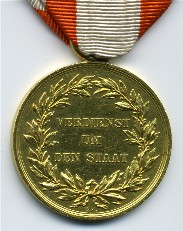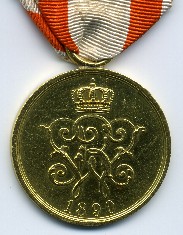|
There are
multiple ways in making fakes of medals. Best results
have certainly been achieved by the
electroplating/-forming process, yet the most widespread
technique is still casting.
The procedure
is very similar to the electroplating process and hence
will stumble over the same problems. It all begins with
taking a mould from the real, original object. This can
be done with a broad variation of different materials,
like clay, plaster or in today's world engineered
plastics.
After taking
the mould melted metal is pored into the mould. Due to
the nature of molding there are escape channels in order
to ensure a complete filling of the mould with the
liquid metal. Those channels cause excess material,
which has to be removed from the fake after the cooling
process.
The observant
reader will have already discovered the initial two
problems of this method:
a) the fake
will only be as good as the mould
b) the fake
might have areas where excess material was removed.
Besides those
two mentioned above the forger has to overcome several
other problems which he can not overcome by simply
working carefully in his preparation stage as well as
detailing the fake after the casting process.
c) metal
expands while heated up and contracts after cooling
down. This caused a slightly smaller fake.
d) the
density of a cast fake is always lower and will result
in a lower weight as well.
So would one
have to do to prevent a fake like this to sneak in ones
collection?
Literature is
definitely a must. Some books/magazines have published
weights of proven original medals which will give a good
indication. Yet, running around with a scale on a medal
fair might not be of great help. Hence I carry a little
jewelers magnifying glass with me. With magnification of
up to 10 most cast fake can be exposed.
Let me give
you an example of a cast fake. It has always easier to
identify something one has seen and understood before.
The following
example is a cast fake of a Prussian "Allgemeine
Ehrenzeichen" General Badge of Honor in Gold:
 |
 |
|
Medal shown at
about 1.5 times its original size. Original
diameter is only 31 mm. |
The original
stamping tool was designed and manufactured by Emil
Weigand. His initials E.W. are on the avers of the medal
right below the laurel leaf wreath. Issued March 17,
1890, only 2380 medals were ever coined but not many
survived.
Certainly a
nice and desirable piece that will tempt a forger.
Looking at it
with the bare eye one will not be able to find anything
wrong with it. Every detail looks just fine and even the
E.W. mark is were it supposed to be.
Lets look a
little bit closer at an enlarged image. Yet, click on
the following picture to get a super sized (1.5 MB)
image of the averse medal for your own examination:
I am sure you
will find various placed that will prove to you that
this is not a coined piece. The whole surface looks
blurry, even though the forger tried to smoothen most of
those areas out. You will find many place like those
below that are a result of a bad mould:
...and yes, having a good scanner is
probably the even better way to determine the difference
between cast fake or electroforming and coined.
© A. Schulze Ising, IX/05 | 




